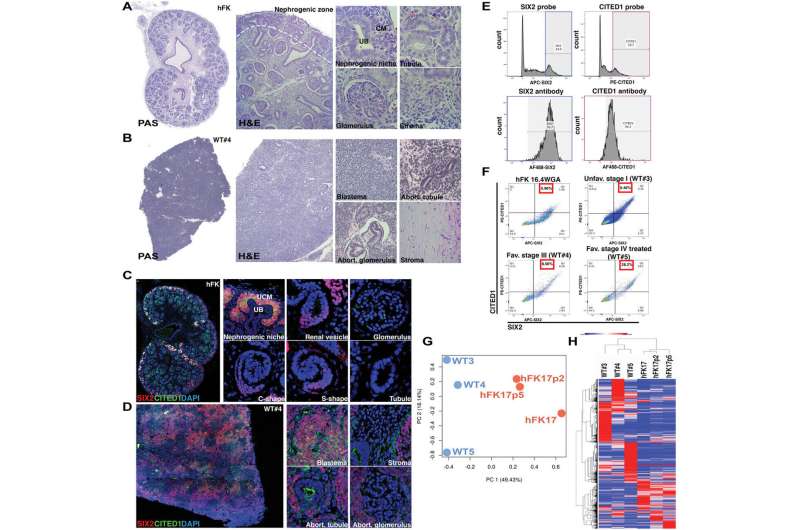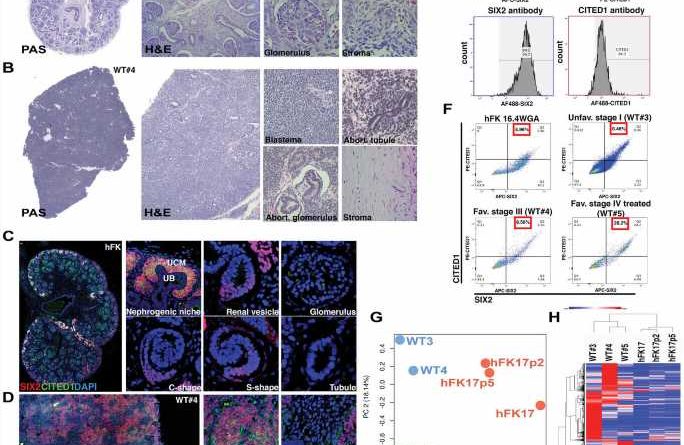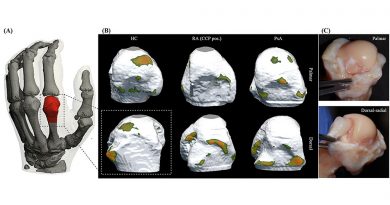Researchers uncover new clues to origins of the most common pediatric kidney cancer

While Wilms tumor—also known as nephroblastoma—is rare, it is the most prevalent childhood kidney cancer. Researchers at Children’s Hospital Los Angeles have now pinpointed a disruption in early kidney progenitor cell development that can be linked to the formation of Wilms tumor.
In a study published in Advanced Science, researchers at the GOFARR Laboratory in Urology compared kidney progenitor cells from a tumor with precursor cells from a healthy kidney. Normally, these precursor cells mature into kidney cells, but when their early development is dysregulated, they behave like cancer stem cells.
While most children with Wilms tumor are successfully treated, current therapies are aggressive. A minority of these patients have unfavorable prognoses or relapses; for these children, there is no existing therapy. “By achieving a more precise understanding of how Wilms tumors develop, our goal is to find new treatments for all types of Wilms tumor,” says Laura Perin, Ph.D., Co-Director of the GOFARR laboratory and senior study co-author with Stefano Da Sacco, Ph.D., another researcher at the GOFARR Laboratory.
Instead of developing into kidney cells, they develop into tumor cells
“Pediatric Wilms tumor can be considered a developmental cancer,” says Dr. Perin, who is also Associate Professor at the Keck School of Medicine of USC. “The normal adult kidney lacks kidney precursor cells, as they are ‘exhausted’ before birth. But in Wilms tumors, instead of giving rise to a functional kidney, these precursor cells persist and form the tumor mass.” The researchers characterized these Wilms tumor kidney precursor cells, finding that these cells can reproduce the original tumor.
“They are aggressive, they’re drug-resistant, they metastasize like cancer cells, and they are able to create the full tumor that we see in patients,” says Astgik Petrosyan, Ph.D., researcher at the GOFARR Lab and first author of the study.
Cells that are oblivious to growth signals
The kidney precursor cells that generate Wilms tumors also abnormally expressed ITGβ1 and ITGβ4, proteins that help cells communicate with their microenvironment. “This abnormal attachment to their microenvironment favors the uncontrolled replication of these cells and guides the formation of the tumor mass,” says Dr. Da Sacco.
“Our findings provide a more accurate understanding of the different stages of both normal and abnormal kidney development,” says Dr. Perin. “This can possibly help the diagnosis of Wilms tumor, leading to more effective treatments for these patients.”
More information:
Astgik Petrosyan et al, Identification and Characterization of the Wilms Tumor Cancer Stem Cell, Advanced Science (2023). DOI: 10.1002/advs.202206787
Journal information:
Advanced Science
Source: Read Full Article



